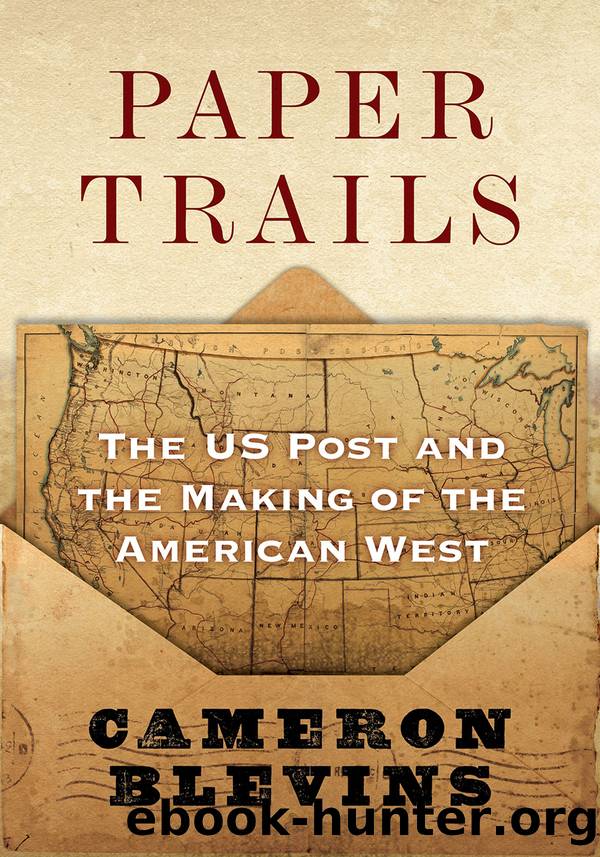Paper Trails by Cameron Blevins

Author:Cameron Blevins [Blevins, Cameron]
Language: eng
Format: epub
Published: 2021-12-15T00:00:00+00:00
National Markets and Regional Streams
North Bloomfield could stand in for a number of western communities in the late 19th century. Located in the foothills of the Sierra Nevada Mountains, the town lay within the regional orbits of several neighboring urban centers. A stage road connected it to nearby Nevada City, which in turn was linked to Sacramento via a 60-mile railroad line. From Sacramento, one could ride 90 miles to San Francisco. North Bloomfield, like so many towns in the West, was dependent on extractive industries. Gold seekers had founded the town in the early 1850s during the California Gold Rush, but over the following decades large-scale mining companies had replaced individual prospectors. One of the largest of these companies was the North Bloomfield Gravel Mining Company. In the late 1870s the company became the object of a famous lawsuit over its hydraulic mining operations, as farmers who lived downriver accused the company of creating silted runoff that had ruined their farms. In 1884, the California Supreme Court banned the practice of hydraulic mining in the state. As the North Bloomfield Gravel Mining Company pared down its operations, the town went into a slow decline. In the 1890s, however, it was still home to roughly one thousand residents, two schools, a church, and a smattering of small businessesâincluding the McKillican and Mobley General Store and post office.43
North Bloomfield was one of thousands of towns that benefited from the Post Office Departmentâs sweeping expansion of the money order service during the last year of Charles Macdonaldâs administration. On October 18, 1892, some 60 California towns were officially inaugurated into the money order system, including the North Bloomfield Post Office.44 The new development was a welcome one for the townâs residents. Previously, sending a money order would have required them to embark on a 28-mile roundtrip journey over mountain roads to either North San Juan or Nevada City. Now, they could simply walk to Walter Mobleyâs general store and immediately remit funds to some 18,000 different locations.45 Fortunately for historians, Mobley saved the copious paperwork from his time as the townâs postmaster, including individual records of the money orders that left his office. Much like the equivalent records saved by the postmaster in Hamilton, Nevada, the records from North Bloomfield capture each orderâs recipient, destination, and sender along with the amount of money remitted. Included in these records are some nine hundred money orders that left the North Bloomfield Post Office over the course of eight months in 1895.46 These scraps of information offer a glimpse into a largely understudied corner of economic history and the commercial integration that was washing over the western United States.
Postal money orders present a bottom-up perspective on how individual people (albeit largely middle- and upper-class people) remitted money from a distance.47 The data from eight monthsâ worth of North Bloomfield money orders, fragmentary as they may be, show some surprising patterns. First, a majority of the townâs money orders went to companies and organizations rather than people.
Download
This site does not store any files on its server. We only index and link to content provided by other sites. Please contact the content providers to delete copyright contents if any and email us, we'll remove relevant links or contents immediately.
| Africa | Americas |
| Arctic & Antarctica | Asia |
| Australia & Oceania | Europe |
| Middle East | Russia |
| United States | World |
| Ancient Civilizations | Military |
| Historical Study & Educational Resources |
Machine Learning at Scale with H2O by Gregory Keys | David Whiting(4183)
Never by Ken Follett(3791)
Fairy Tale by Stephen King(3220)
The Man Who Died Twice by Richard Osman(2997)
Oathbringer (The Stormlight Archive, Book 3) by Brandon Sanderson(2881)
Will by Will Smith(2793)
Rationality by Steven Pinker(2291)
The Dark Hours by Michael Connelly(2243)
Can't Hurt Me: Master Your Mind and Defy the Odds - Clean Edition by David Goggins(2228)
The Dawn of Everything: A New History of Humanity by David Graeber & David Wengrow(2122)
Friends, Lovers, and the Big Terrible Thing by Matthew Perry(2119)
Principles for Dealing With the Changing World Order: Why Nations Succeed and Fail by Ray Dalio(1974)
HBR's 10 Must Reads 2022 by Harvard Business Review(1777)
A Short History of War by Jeremy Black(1762)
Go Tell the Bees That I Am Gone by Diana Gabaldon(1687)
515945210 by Unknown(1599)
A Game of Thrones (The Illustrated Edition) by George R. R. Martin(1589)
Kingdom of Ash by Maas Sarah J(1526)
443319537 by Unknown(1470)
